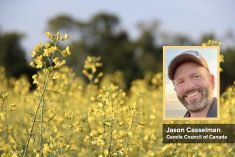It’s the usual tradeoff: the agricultural research community has to balance promising new concepts in pest management against ease of use and efficiency gains for farmers.
One such concept, an integrated pest management strategy called “trap cropping,” hasn’t always been an easy sell.
The basic concept is that pests are controlled in a lower-value crop bordering the main crop and making up 10 per cent or less of the field. If economic threshold levels are reached in the trap crop border, the producer can only spray that area, avoiding the expense of spraying the whole field and potentially minimizing harm to beneficial insects in the rest of the field.
Read Also

Could crop sharing be a viable option for your farm?
Crop sharing could be a good option for young and beginning farmers.
More than 15 years ago, Agriculture and Agri-Food Canada researcher Hector Carcamo published research looking at the use of trap crops to control cabbage seedpod weevil in canola.
Carcamo’s research, conducted on southern Alberta canola fields between 2000 and 2003, found that borders planted with Brassica rapa (Polish canola) flowered a week earlier than the main crop of Brassica napus (Argentine canola), and concentrated very high numbers of cabbage seedpod weevil. Planting the same Argentine canola cultivar a week earlier than the main crop also worked, says Carcamo. By spraying just the trap crop borders when cabbage seedpod weevil reached economic thresholds, the researchers saw significant cost savings.
It sounded good, but Carcamo says farmers were reluctant to adopt the practice. Seeding two varieties in a field meant two runs with the seeder or two seeding events, and two separate harvest dates for each field later.
But trap crops might yet have their day. Carcamo has proposed new research that will revisit the concept with new shatter-resistant varieties of canola.
They spell the difference. With older varieties, farmers had to swath during narrow harvest windows. With shatter-resistant varieties, harvest windows are wider and farmers can straight cut their canola. They could fill a seed box with the border variety, seed the border, then switch to the main crop seed for the rest of the field, explains Carcamo. At the end of the season, since they can afford to wait until both crops have matured, both can be harvested together.
“So it doesn’t matter too much if you have two cultivars that have a five- to seven-day maturity difference. (Farmers are) harvesting peas first, then barley, then wheat, and they have the luxury of leaving canola longer — late summer or early fall. If you have a slight difference in maturity times, the two crops catch up.”

Bees as pest control
Carcamo’s proposed research project includes some intriguing new pest control approaches.
One is the use of a biological insecticide containing the fungus Beauveria bassiana, which can control immature and adult thrips, whiteflies, lygus and aphids and other insects. It’s registered in Canada, although not yet in canola. He also hopes to study insect-pathogenic bacteria that could provide a similar service.
Carcamo says products like these are attractive for field crop research because they have “softer” off-target effects than conventional insecticides.
Another technology hoped to take to field trials is Guelph researcher Peter Kevan’s concept of apivectoring — short for “apiculture vectoring” — which uses pollinators like honeybees and bumblebees to carry pest-controlling microbes to crops. Kevan and his colleagues’ pioneering design is a dispenser on the hive’s exit path; the bees walk through powder containing the microbe spores and carry them to flowers, where pests then get infected.
Carcamo says the technology has been used successfully in many Canadian greenhouse crops as well as field crops in other countries. He believes it could work well in tandem with trap crops in canola fields, mainly due to the flowering time of the trap crop.
“I think the trap microbial insecticide bee vectoring could be efficacious because you have a large number of canola plants flowering in early June when not a lot of other crops are flowering,” he says.
Once Carcamo’s proposal and funding come together, he hopes to assemble a team to conduct environmental impact assessments to document benefits to climate change mitigation and biodiversity and — crucially for farmers — economic analyses.
Carcamo points to a recent emphasis on the importance of protecting beneficial insects, in campaigns like the Western Grains Foundation’s “Field Heroes,” as evidence that more and more farmers are invested in minimizing harm to pollinators and other beneficial insects.
This time around, trap crops might be a winning proposition.
Carcamo has published a useful guide to the use of trap crops at researchgate.net.
















